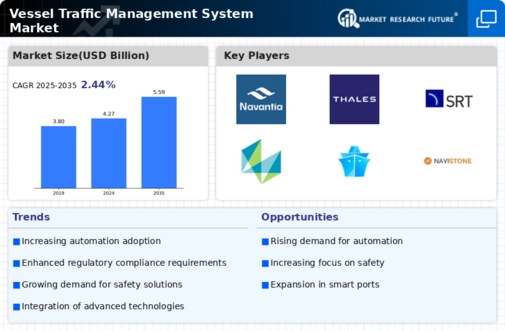Market Analysis
In-depth Analysis of Vessel Traffic Management System Market Industry Landscape
The Vessel Traffic Management System (VTMS) market is characterized by dynamic and evolving market dynamics driven by a combination of factors. One key dynamic is the increasing global maritime trade, which fuels the demand for effective traffic management solutions. As trade volumes continue to rise, the pressure on maritime authorities and shipping companies to ensure the safety and efficiency of vessel movements intensifies, thereby propelling the growth of the VTMS market.
Technological advancements play a pivotal role in shaping the market dynamics of VTMS. The integration of advanced technologies, such as Automatic Identification System (AIS), radar systems, and satellite communication, enhances the monitoring and management capabilities of VTMS solutions. The constant evolution of these technologies drives innovation within the market, with companies striving to stay ahead by incorporating the latest advancements into their offerings. This dynamic creates a competitive environment where technological prowess becomes a key differentiator.
Regulatory developments and compliance standards contribute significantly to the market dynamics. Governments and international maritime organizations continue to establish and enforce regulations aimed at improving maritime safety and security. The need for compliance with these standards drives the adoption of advanced VTMS solutions by port authorities and shipping companies. Changes in regulatory landscapes can trigger market shifts as stakeholders adjust their strategies to align with new requirements, creating a dynamic environment for VTMS providers.
The geographical distribution of maritime activities plays a crucial role in shaping market dynamics. Regions with high maritime traffic, such as major shipping routes or busy trade hubs, experience greater demand for robust VTMS solutions. Coastal areas with congested waterways also contribute to the dynamics by necessitating the implementation of effective traffic management systems. The market responds to the varying needs of different regions, leading to a diverse range of solutions and strategies tailored to local conditions.
Cybersecurity considerations add a layer of complexity to the dynamics of the VTMS market. As these systems become more interconnected and reliant on digital technologies, the risk of cyber threats increases. The market dynamics are influenced by the continuous efforts of VTMS providers to enhance cybersecurity features, ensuring the integrity of communication, navigation, and surveillance systems. The evolving nature of cyber threats requires constant adaptation, making cybersecurity a dynamic aspect of the VTMS market.
Economic factors contribute to the market dynamics as well. Government investments in maritime infrastructure, budget allocations, and overall economic stability influence the growth of the VTMS market. Economic downturns may lead to temporary slowdowns in investments, while periods of growth and stability can spur increased spending on modernizing and upgrading port facilities and navigation systems.
Collaboration and partnerships are dynamic elements in the VTMS market, where stakeholders seek to enhance their capabilities through joint efforts. Strategic alliances between VTMS providers, port authorities, shipping companies, and technology vendors contribute to the development of integrated and comprehensive solutions. These collaborative efforts often result in synergies that address complex challenges and foster innovation, driving positive market dynamics.
















Leave a Comment